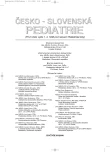Spinal Epidural Abscess in a Sixteen Years Old Boy Case report and review of literature
Authors:
J. Gut 1; A. Cipra 2; D. Procházková 2; J. Pajerek 2; R. Bartoš 3; M. Derner 4; J. Daumová 5
Authors‘ workplace:
Dětské oddělení NsP, Česká Lípa
primář MUDr. J. Gut
1; Dětská klinika Masarykovy nemocnice, Ústí nad Labem
primář MUDr. J. Škvor, CSc.
2; Neurochirurgické oddělení Masarykovy nemocnice, Ústí nad Labem
přednosta doc. MUDr. M. Sameš, CSc.
3; Rentgenologické oddělení Masarykovy nemocnice Ústí nad Labem
primář MUDr. M. Derner
4; Rentgenologické oddělení NsP Česká Lípa
primářka MUDr. H. Čerbáková
5
Published in:
Čes-slov Pediat 2008; 63 (6): 306-312.
Category:
Case Report
Overview
Spinal epidural abscess (SEA) is a rare disease especially at the child age. Only tens of case reports have been published so far. It is certainly a disease of a high degree of risk for the development of permanent neurological lesion and even the risk of fatal end.
Classical triad (back pain, febrile conditions, neurological topical deficit) occurs only in a part of patients and the disease therefore often escapes early recognition for unspecific symptoms. The method of diagnostic examination includes spiral CT or MR of the spinal region. The degree of the disease is the basis for considering between a conservative procedure of long-term parenteral therapy with antibiotics or neurosurgical laminectomy with drainage of the abscess. The prognosis if favorable in early diagnosis and adequate treatment are applied.
The demonstrated case of a 16-year boy is the first case of SEA at the child age in available Czech literature. The boy was admitted for a febrile condition, lumbalgia, left- side lumbar paravertebral painful contracture and slightly elevated inflammatory markers. For the progression of complaints in spite of ATB administration and for diagnostic uncertainties, the authors indicated spiral CT examination in the search for spinal or paraspinal pyogenic affection, which revealed SEA confirmed subsequently by MR. The patient was treated conservatively without the need of neurosurgery.
Key words:
spinal epidural abscess, laminectomy, intraspinal pyogenic infection, Staphylococcus aureus
Sources
1. Bair-Merritt MH, Chung Ch, Collier A. Spinal epidural abscess in a young child. Pediatrics 2000;106: 3.
2. Darouiche RO. Spinal epidural abscess. New Engl. J. Med. 2006;355(19): 2012–2020.
3. Enberg RN, Kaplan RJ. Spinal epidural abscess in children. Neurology 1974;71: 208–210.
4. Kala M, Vaverka M, Buřval S. Hnisavé procesy v páteřním kanále – klinické zkušenosti. Čes. a Slov. Neurol. Neurochir. 1997;60: 288–292.
5. Rockney R, Ryan R, Knuckey N. Spinal epidural abscess. Clin. Pediatrics 1989;28(7): 332–334.
6. Rubin R, Michowiz S, Ashkenasi S, et al. Spinal epidural abscess in the pediatric age group: case report and review of the literature. Pediatr. Infect. Dis. J. 1993;12: 1007–1011.
7. Smíšková D, Seidl Z. Spinální epidurální absces u dvanáctiletého chlapce. Lékařské Listy ZN 2006;8: 8–9.
8. Vaňásková Z, Krajíčková D, Hlatký R, Malec R. Spinální epidurální absces v krční lokalizaci. Čes. a Slov. Neurol. Neurochirur. 1997;60: 285–287.
Labels
Neonatology Paediatrics General practitioner for children and adolescentsArticle was published in
Czech-Slovak Pediatrics

2008 Issue 6
Most read in this issue
- Examination Procedure in the Child with Proteinuria
- Intrauterine Growth Retardation and Fetal Origin of Diseases at the Adult Age
- Therapy of Inborn Spine Deformities
- Spinal Epidural Abscess in a Sixteen Years Old Boy Case report and review of literature
